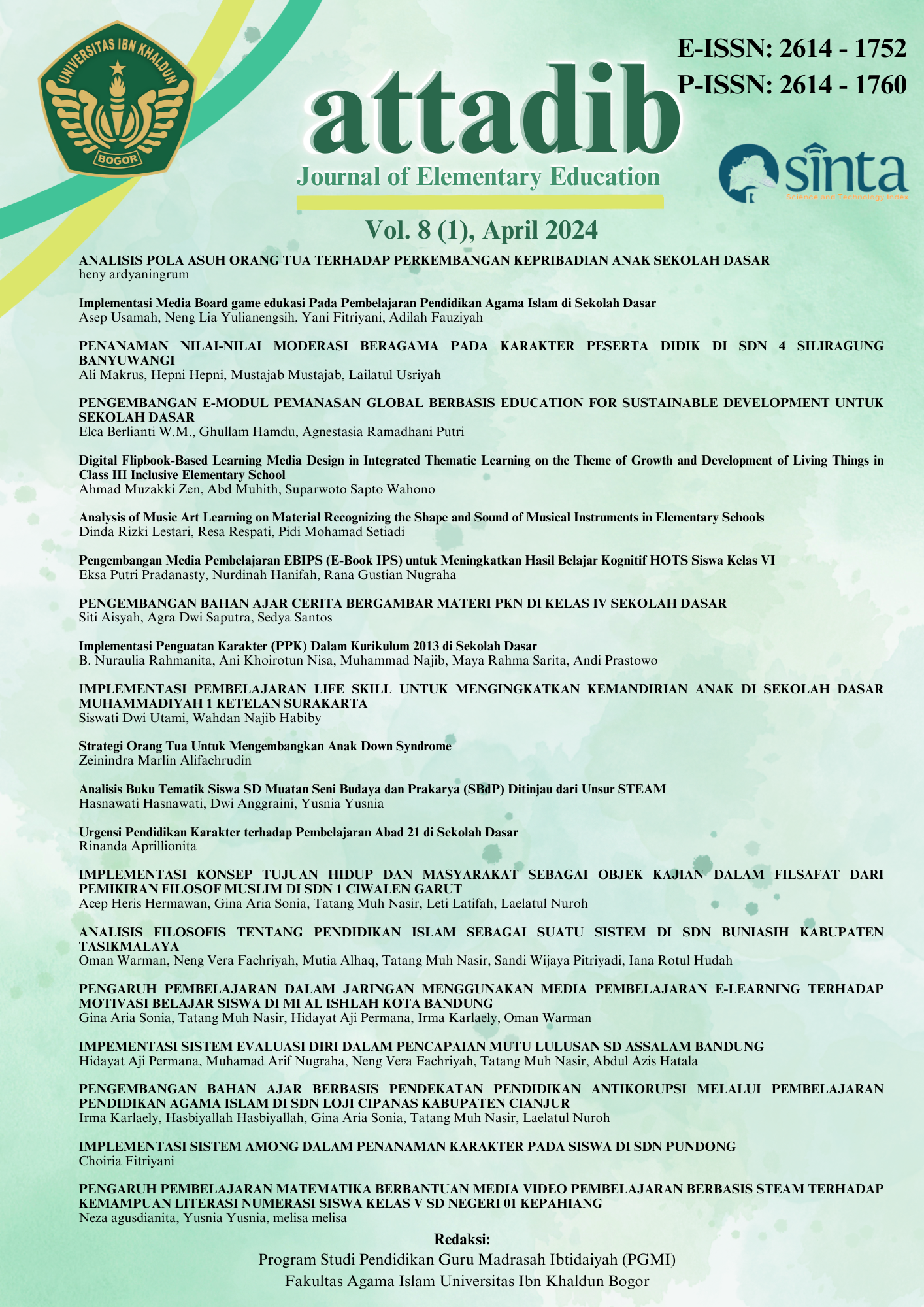MODEL PEMBELAJARAN TWO-STAY TWO-STRAY (TS-TS) UNTUK MENINGKATKAN HASIL BELAJAR DAN SIKAP KERJASAMA SISWA
DOI:
https://doi.org/10.32832/at-tadib.v3i1.19382Keywords:
two-stay two-stray; learning outcomes; attitude of cooperationAbstract
Learning is a formal activity carried out at school. In this case the occurrence of an interaction between students, teachers and their environment. The role of a teacher is very important, it will greatly affect the learning outcomes and student development. This study aims to determine the application of a two-stray two-stay learning model that can improve learning outcomes and students' cooperative attitudes in fourth grade science subjects MI Jam’iyatul Falah Bojong Gede Bogor Regency. The method used is classroom action research using the Kemmis Mc. Taggart model consisting of planning, implementation, observation and reflection. The results showed that student learning outcomes in pre-cycle with completeness percentage value of 56.25%, in cycle one the completeness percentage value was 75%, then in cycle two the completeness percentage value was 87.5%. The attitude of student collaboration on pre cycle average value of 2.45 with sufficient category, in cycle one the average value is 2.85 with good category, and in cycle two the average value is 3.5 with a very good category. This the application of a two-stray two-stay learning model can improve learning outcomes and the cooperative attitude of students in fourth grade science subjects in MI Jam'iyatul Falah Bojong Gede Bogor Regency.
References
Faiziddin, Moh. (2016). Peningkatan Kemampuan Kerja Sama melalui Kegiatan Kerja Kelompok Pada Anak Kelompok A TK Kartika Salo Kabupaten Kampa. Jurnal PGPAUD STKIP PTT, Volume II, Nomor 1. (online) https://obsesi.or.id/index.php/obsesi/article/view/47. 19 Februari 2019.
Huda, Miftahul. (2014). Model-Model Pengajaran dan pembelajaran.
Yogyakarta: Pustaka Pelajar.
Herawati. (2015). Penerapan Model Pembelajaran Two Stay Two Stray Untuk Meningkatkan Prestasi Belajar Siswa Pada Materi Keliling Dan Luas Lingkaran Di Kelas VI SD Negeri 53 Banda Aceh. Jurnal Peluang, Volume III, Nomor 2. (online)
http://www.jurnal.unsyiah.ac.id/peluang/article/view/5720. 12 Januari 2019. Isrok’atun dan Amelia Rosmala. (2018). Model-Model Pembelajaran Matematika.
Jakarta: Bumi Aksara.
Jalil, Jasman. (2014). Panduan Mudah Penelitian Tindakan Kelas (PTK). Jakarta: Prestasi Pustakaraya.
Kumape, Satilin. (2015). Pengaruh Penerapan Model Pembelajaran Kooperatif Tipe Two Stay Two Stray Terhadap Aktivitas dan Hasil Belajar Siswa Tentang IPA di Kelas VI SD Inpres Palupi. Jurnal Kreatif Tadulako Online, Vol. IV, No. 4. (online)
http://scholar.google.co.id/scholar?start=80&q=model+pembelajaran+two+s tay+two+stray&hl=id&as_sdt=0,5 19 Februari 2019.
Majid, Abdul. (2017). Pembelajaran Tematik Terpadu. Bandung: PT Remaja Rosdakarya
Rhiantini, Sari. Dkk. (2017). Penerapan Metode Two-Stay Two-Stray Upaya Meningkatkan Keterampilan Menulis Pada Materi Laporan Pengamatan. Jurnal Pena Ilmiah, Vol II, No 1. (Online)
Http://Ejournal.Upi.Edu/Index.Php/Penailmiah/Article/View/9533/Pdf_1. 18 Juni 2019.
Rukmia. (2016). Meningkatkan Hasil Belajar Siswa Melalui Model Pembelajaran Kooperatif Tipe Jigsaw Dalam Pembelajaran IPA Materi Pesawat Sederhana Di Kelas V SDN No. 1 Balukang II. Jurnal Kreatif Tadulako Online, Vol. IV, No. 1. (Online) http://jurnal.untad.ac.id/jurnal/index.php/JKTO/article/view/3292. 12
Januari 2019
Susanto, Ahmad. (2014). Teori Belajar dan Pembelajaran di Sekolah Dasar.
Jakarta: Prenadamedia Group.
Wisudawati, Asih Widi dan Eka Sulistyowati. (2013). Metodologi Pembelajaran IPA. Jakarta: Bumi Aksara.
























